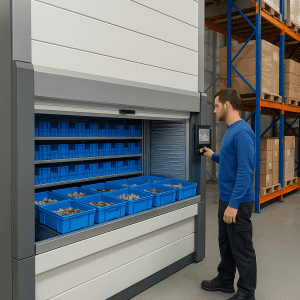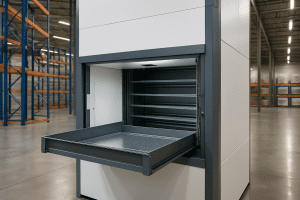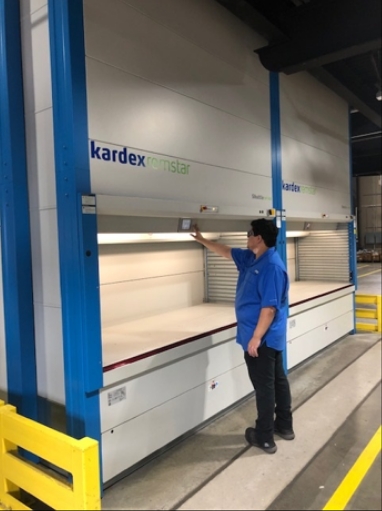Warehouses today face a growing list of pressures — higher order volumes, faster delivery expectations, SKU proliferation, and rising labor costs. For many operations, simply adding more shelving or hiring more workers isn’t enough to stay competitive. That’s why more facilities are turning to automated lift systems, a modern storage technology designed to reduce labor, speed up picking, and eliminate wasted motion across the warehouse.
Automated lifts are no longer a niche technology reserved for large manufacturers. From MRO rooms and e-commerce fulfillment centers to aerospace, automotive, and medical device facilities, these systems deliver consistent ROI by transforming how inventory is stored and accessed.
This guide breaks down how automated lift systems work, what makes them so effective, and how they dramatically cut labor hours while improving picking speed and accuracy.
What Is an Automated Lift System?
An automated lift is a vertical storage system that brings items directly to the operator instead of requiring them to search aisles or climb ladders. The system automatically retrieves the requested tray, bin, or shelf and delivers it to an ergonomic access point at waist height.
There are two primary categories of automated lift systems:
1. Vertical Lift Modules (VLMs)
VLMs use an extractor at the center of the unit to pull trays from storage and deliver them to the operator. These systems optimize vertical space, often recovering up to 90% of a floor footprint compared to traditional shelving.
📌 Explore VLMs:
Vertical Lift Modules (VLMs)
2. Vertical Carousels
A vertical carousel rotates inventory like a Ferris wheel, cycling shelves to the access opening. They are ideal for repetitive, high-frequency picking and secure inventory storage.
📌 Learn more:
Vertical Carousel Storage Systems
Both systems are classified broadly as “automated lifts” because their core function is identical: they automate the storage and retrieval of inventory to reduce manual labor and significantly increase throughput.
Why Automated Lift Systems Are Becoming Essential
Warehouses are under more pressure than ever to do more with less:
Labor costs continue to rise
Fewer workers are entering warehouse jobs
Order accuracy expectations are higher
Space constraints are common
Safety standards are tightening
Automated lifts solve these issues simultaneously by bringing the inventory directly to the worker. Instead of walking, bending, climbing, searching, and manually handling inventory, workers interact with a single ergonomic access point where everything arrives automatically.
This “goods-to-person” workflow is fundamentally faster, safer, and more resilient than traditional picking.
How Automated Lift Systems Reduce Labor Requirements
Labor optimization is the #1 driver behind automated lift adoption. Here’s how these systems reduce labor hours and overhead.
1. Eliminating Walk Time (Up to 70% of Labor)
Most pickers walk 5–10 miles per shift. Automated lifts collapse that to almost zero. Workers no longer:
Walk aisles
Search manually
Climb ladders
Navigate crowded warehouse areas
This slashes non-productive labor and boosts throughput without adding more staff.
2. Reducing Picking Staff Requirements
Because automated lifts handle the traveling, searching, and positioning, one operator can do the work of several manual pickers.
A typical comparison:
| Task | Traditional Shelving | Automated Lift |
|---|---|---|
| Daily picks | ~120 lines per picker | 250–400+ lines per picker |
| Operators required | 3–5 | 1–2 |
| Training time | Weeks | Hours |
It’s common for companies to reduce labor requirements by 25–50% after deploying automated lift systems.
3. Faster Onboarding & Cross-Training
Automated lifts rely on inventory software that guides operators step-by-step. No warehouse layout knowledge is required.
This means:
New hires become productive faster
Seasonal workers are easier to train
Existing workers can be reallocated to higher-value roles
Automation allows your experienced team to focus on productivity, not on memorizing storage locations.
4. Reducing Physical Strain and Worker Fatigue
Automated lifts eliminate bending, stretching, lifting, and climbing — the physical motions responsible for most warehouse injuries.
This reduces:
Strain injuries
Workers’ comp claims
Fatigue
Employee turnover
And it increases long-term worker retention and safety.
How Automated Lifts Improve Picking Speed & Accuracy
Automated lift systems don’t just reduce labor — they massively improve picking performance.
1. Goods-to-Person Technology Cuts Search Time to Zero
The system retrieves the exact tote or tray requested and delivers it to the access opening.
There is no searching — the biggest bottleneck in manual picking.
2. Software Integration Ensures 99%+ Accuracy
Every automated lift integrates with intelligent inventory software that manages:
SKU locations
Bin tracking
Access control
Pick confirmations
Restock accuracy
This increases picking accuracy from typical ~92% to 99%+.
📌 Learn about warehouse inventory control:
Warehouse Storage Solutions
3. Pick-to-Light and Verification Guidance
Automated lifts often include:
LED pick lights
Laser pointers
Bin illumination
Barcode or RFID scanning
This visual guidance lets operators confirm each pick instantly — reducing hesitation and eliminating mis-picks.
4. Multi-Order Picking Boosts Throughput
With batch-picking software, automated lifts support multiple orders at once. Instead of handling one order at a time, the system optimizes tray sequencing.
This often results in:
30–50% faster overall picking
Shorter fulfillment cycles
Greater order capacity per shift
Perfect for high-mix, fast-moving operations.
5. Faster Cycle Counting & Restocking
Automated lifts streamline cycle counting by allowing operators to call trays automatically and validate inventory quickly.
Companies typically reduce cycle counting time by 50–70%.
Automated Lifts Save Space & Improve Layout Efficiency
Space is one of the biggest constraints in any warehouse. Automated lifts dramatically increase usable storage capacity.
Benefits include:
Up to 90% floor space reduction
Better vertical use of existing ceiling height
Elimination of long picking aisles
Higher security & product protection
Greater density in climate-controlled rooms
📌 See more layout options here:
Warehouse Storage Solutions
ROI: How Automated Lift Systems Deliver Fast Payback
Most operations see ROI in 12–24 months, thanks to:
Lower labor requirements
Faster picking
Higher accuracy
Better space utilization
Reduced product damage
Improved employee safety
Fewer mis-picks and returns
Industries benefiting today include aerospace, automotive, medical device manufacturing, defense, electronics, retail, MRO rooms, and more.
Is an Automated Lift System Right for Your Warehouse?
Automated lifts deliver the most value when operations:
Have high SKU variety
Face space constraints
Struggle to hire or retain labor
Need higher accuracy
Deal with long walk times
Require tight security
Need faster order turnaround
If any of these apply, automated lifts are one of the most cost-effective automation upgrades available.
Why Partner With Vertical Storage USA
Vertical Storage USA specializes in providing turn-key automated lift solutions including:
Integration with WMS/ERP platforms
Full warehouse space analysis
📌 Start with a free assessment:
Request a Free Space Analysis
Conclusion
Automated lift systems simplify warehouse operations by eliminating travel time, increasing pick speed, and improving accuracy through software-driven workflows. They free up labor, reduce strain, and unlock massive space savings — all while supporting future automation growth.
For operations under pressure to do more with less, automated lifts are one of the fastest ways to modernize without expanding your facility.
FAQ: Automated Lift Systems
What is an automated lift system?
A vertical automated storage system that retrieves inventory automatically and delivers it to the operator.
How much space can an automated lift save?
Most operations reclaim 70–90% of floor space.
How fast can automated lifts pick?
Operators often achieve 250–400+ lines per hour, depending on system configuration.
Do automated lifts replace workers?
No — they reduce labor requirements and allow staff to focus on higher-value tasks.
How long does installation take?
Between 1–3 days, depending on size.





